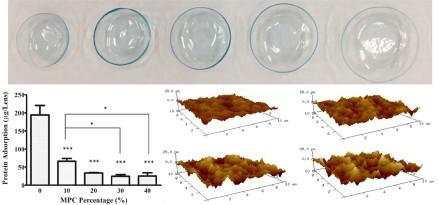Macromolecular Research ( IF 2.8 ) Pub Date : 2020-10-27 , DOI: 10.1007/s13233-020-8149-2 Wan-Hsin Chang , Pei-Yi Liu , Chien-Ju Lu , Dai-En Lin , Min-Hsuan Lin , Yuan-Ting Jiang , Yuan-Hao Howard Hsu

|
Biocompatible 2-methacryloyloxyethyl phosphorylcholine (MPC) can enhance the adsorption of water molecules and is therefore used for manufacturing contact lenses. This study investigated the mechanical strength, anti-protein deposition, and anti-lipid adsorption effects of MPC addition to contact lenses. Experimental contact lenses produced by copolymerizing multiple ratios of MPC to 2-hydroxyethyl methacrylate (HEMA) were analyzed. Atomic force microscopy revealed that MPC addition increased surface roughness. The anti-protein deposition and anti-lipid adsorption effects on poly(HEMA-MPC) polymers of various phosphorylcholine quantities were experimentally confirmed. The water content of the contact lenses was proportional to the MPC content in the polymer. The hydrated PC moiety of MPC drastically altered the network of the poly-HEMA polymer by inserting water molecules, which were trapped in the concave region of the surface. MPC addition had negative effects on all examined strength factors because of structural destabilization of the copolymer through water insertion. The anti-deposition effects of MPC were verified by examining the lysozyme and lipid adsorption abilities of the prepared contact lenses. Our results revealed that MPC enhanced interactions of the poly(HEMA-MPC) copolymer with water molecules; these interactions weakened the mechanical strength of the copolymer but markedly improved the anti-adsorption property of the biomolecules. The optimal proportion of HEMA-MPC for contact lenses is in the range 14.9%–28.5%.
中文翻译:

通过添加2-甲基丙烯酰氧基氧乙基磷酸胆碱来降低隐形眼镜的物理强度并增强其抗蛋白质和抗脂质的吸附能力
生物相容性2-甲基丙烯酰氧基乙基磷酰胆碱(MPC)可以增强水分子的吸附,因此可用于制造隐形眼镜。这项研究调查了MPC除隐形眼镜外的机械强度,抗蛋白质沉积和抗脂质吸附作用。分析了通过将多种比例的MPC与甲基丙烯酸2-羟乙酯(HEMA)共聚生产的实验性隐形眼镜。原子力显微镜显示添加MPC会增加表面粗糙度。实验证实了各种磷酰胆碱对聚(HEMA-MPC)聚合物的抗蛋白质沉积和抗脂质吸附作用。隐形眼镜的水含量与聚合物中的MPC含量成正比。MPC的水合PC部分通过插入水分子而极大地改变了聚HEMA聚合物的网络,水分子被困在表面的凹入区域中。MPC的添加对所有检测到的强度因子均具有负面影响,这是因为共聚物通过水插入而导致结构不稳定。通过检查制备的隐形眼镜的溶菌酶和脂质吸附能力,验证了MPC的抗沉积作用。我们的结果表明,MPC增强了聚(HEMA-MPC)共聚物与水分子的相互作用;这些相互作用削弱了共聚物的机械强度,但显着提高了生物分子的抗吸附性能。隐形眼镜的HEMA-MPC最佳比例在14.9%–28.5%的范围内。被困在表面的凹形区域中。MPC的添加对所有检测到的强度因子均具有负面影响,这是因为共聚物通过水插入而导致结构不稳定。通过检查制备的隐形眼镜的溶菌酶和脂质吸附能力,验证了MPC的抗沉积作用。我们的结果表明,MPC增强了聚(HEMA-MPC)共聚物与水分子的相互作用;这些相互作用削弱了共聚物的机械强度,但显着提高了生物分子的抗吸附性能。隐形眼镜的HEMA-MPC最佳比例在14.9%–28.5%的范围内。被困在表面的凹形区域中。MPC的添加对所有检测到的强度因子均具有负面影响,这是因为共聚物通过水插入而导致结构不稳定。通过检查制备的隐形眼镜的溶菌酶和脂质吸附能力,验证了MPC的抗沉积作用。我们的结果表明,MPC增强了聚(HEMA-MPC)共聚物与水分子的相互作用;这些相互作用削弱了共聚物的机械强度,但显着提高了生物分子的抗吸附性能。隐形眼镜的HEMA-MPC最佳比例在14.9%–28.5%的范围内。通过检查制备的隐形眼镜的溶菌酶和脂质吸附能力,验证了MPC的抗沉积作用。我们的结果表明,MPC增强了聚(HEMA-MPC)共聚物与水分子的相互作用;这些相互作用削弱了共聚物的机械强度,但显着提高了生物分子的抗吸附性能。隐形眼镜的HEMA-MPC最佳比例在14.9%–28.5%的范围内。通过检查制备的隐形眼镜的溶菌酶和脂质吸附能力,验证了MPC的抗沉积作用。我们的结果表明,MPC增强了聚(HEMA-MPC)共聚物与水分子的相互作用;这些相互作用削弱了共聚物的机械强度,但显着提高了生物分子的抗吸附性能。隐形眼镜的HEMA-MPC最佳比例在14.9%–28.5%的范围内。











































 京公网安备 11010802027423号
京公网安备 11010802027423号